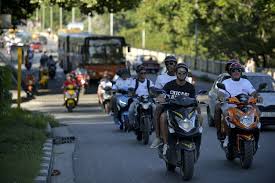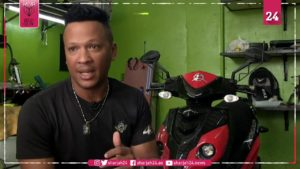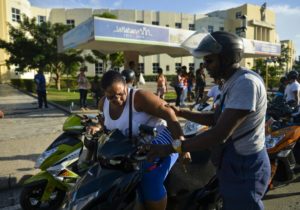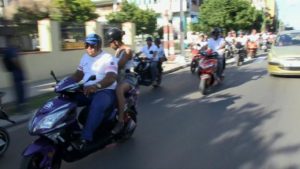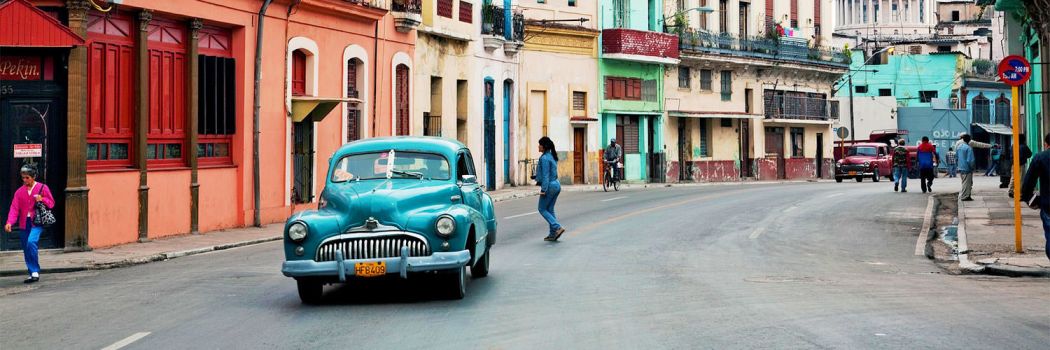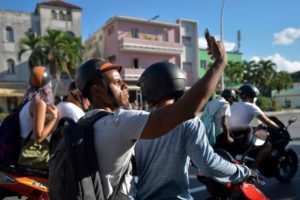 LAS MOTOCICLETAS (“MOTORINAS”) LLEGAN AL RESCATE ANTE LA ESCASEZ DE COMBUSTIBLE EN CUBA.
LAS MOTOCICLETAS (“MOTORINAS”) LLEGAN AL RESCATE ANTE LA ESCASEZ DE COMBUSTIBLE EN CUBA.
Es una hora pico en La Habana y la cola en la parada de autobús es más larga que nunca. Entonces aparece una flota de motocicletas eléctricas que suenan sus bocinas.
Sorprendidos y aliviados, los pasajeros saltan a lomos de los aproximadamente 50 ciclomotores eléctricos.
Es una nueva solución para los cubanos que luchan con la escasez de combustible impulsada por las sanciones estadounidenses que han frenado las importaciones de petróleo.
Cuba ha sido conocida por los autos clásicos estadounidenses que las personas aquí mantienen amorosamente décadas después de que dejaron de fabricarse.
Pero el transporte urbano en la isla comunista está evolucionando. Las bocinas de las bicicletas suenan y algunos de los ciclistas tocan música de reggaeton, pero, al ser eléctricos, sus motores apenas hacen ruido. Una motocicleta eléctrica de fabricación china cuesta entre $ 1,800 y $ 2,300 en Cuba. Una bicicleta básica de gasolina en la isla puede costar hasta seis veces más.
Las bicicletas eléctricas, con una velocidad máxima de aproximadamente 50 kilómetros por hora, se autorizaron por primera vez para la importación en 2013. Se han multiplicado en las calles desde entonces, y se han vuelto propias con la reciente escasez de combustible.
Cuba se sumió en una crisis de combustible en septiembre después de que Washington impuso restricciones a los envíos de combustible desde el principal aliado de Cuba, Venezuela. Cuba tuvo que arreglárselas en septiembre con solo el 30 por ciento de su suministro de combustible habitual y el nivel aún no se ha recuperado; se pronostica que no alcanzará más del 80 por ciento este mes.
Con la red de transporte público gravemente afectada, el presidente Miguel Díaz-Canel ha pedido a los conductores que recojan a los pasajeros voluntariamente.
Los propietarios de bicicletas eléctricas conocidas como “motorinas” respondieron a la llamada.
Las autoridades cubanas estiman que hay 210,000 motocicletas eléctricas actualmente en uso en la isla. Se espera que esa cifra aumente a medida que el gobierno a fines de octubre comenzó a venderlos con un precio máximo de $ 1,700.
Aquellos que se ganan la vida dando servicio a las bicicletas están contentos con ese movimiento, ya que reducirá los costos.
“Nos parece una muy buena idea para los mecánicos”, dice uno, Enrique Alfonso, de 47 años, en su taller. Recuerda la crisis económica de la década de 1990 que siguió al final de las importaciones baratas de la Unión Soviética. “Esa fue la era de las bicicletas chinas (asequibles). Ahora estamos en la era de las motocicletas eléctricas”, dice. “Con todo lo que está sucediendo en el país, se han vuelto accesibles para mucha gente”.
Las bicicletas eléctricas tuvieron una recepción mixta al principio. Silenciosos y a menudo inexpertos, a menudo están involucrados en accidentes en un país que ya sufre miles de accidentes al año.
El florecimiento de las bicicletas eléctricas sigue a varios años de apertura gradual de la economía estatal cubana. También ha coincidido con una mini revolución digital. Gracias a la disponibilidad de conexiones a Internet estándar 3G desde el año pasado, los usuarios pueden conectarse en red más fácilmente.
Las conexiones 3G ayudaron a generar el grupo en línea de Electric Motorbikes of Cuba, un club con más de 80 miembros.
Comenzó como un club para entusiastas que buscaban “divertirse sanamente y compartir la pasión que todos tenemos por las motocicletas eléctricas y la seguridad vial”, dice su presidente Osdany Fleites, un taxista de 37 años. “Las motocicletas no contaminan el medio ambiente, no hacen ruido”, dice.
Ahora el club ha evolucionado para tener un propósito ambiental y “social”.
Junto con otro club, Eracing, sus miembros participan en el rescate de pasajeros de autobuses atrapados debido a la escasez de combustible.
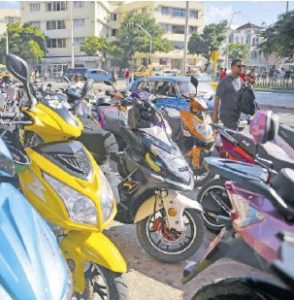 MOTORCYCLES (“MOTORINAS”) RIDE COMES TO THE RESCUE IN FUEL-SHORT CUBA.
MOTORCYCLES (“MOTORINAS”) RIDE COMES TO THE RESCUE IN FUEL-SHORT CUBA.
In a rush hour in Havana and the queue at the bus stop is longer than ever. Then a fleet of electric motorcycles appears, beeping their horns.
Surprised and relieved, passengers jump on the backs of the 50 or so electric mopeds.
It is a new solution for Cubans struggling with fuel shortages driven by US sanctions that have curbed oil imports.
Cuba has long been known for the classic American cars that people here lovingly maintain decades after they stopped being built.
But urban transport on the communist island is evolving. The bikes’ horns beep and some of the riders play reggaeton music — but, being electric, their motors make hardly any noise. A Chinese-made electric motorcycle costs between $1,800 and $2,300 in Cuba. A basic petrol-powered bike on the island can cost up to six times that.
The electric bikes — with a maximum speed of about 50 kilometers per hour — were first licensed for import in 2013. They have multiplied in the streets since then — and have come into their own with the recent fuel shortages.
Cuba plunged into a fuel crisis in September after Washington imposed restrictions on fuel shipments from Cuba’s top ally Venezuela. Cuba had to make do in September with just 30 percent of its usual fuel supply and the level has still not recovered — it is forecast to reach no more than 80 percent this month.
With the public transport network badly hit, President Miguel Diaz-Canel has called on drivers to pick up passengers voluntarily.
The owners of electric bikes known as “motorinas” answered the call.
The president himself during a televised address mentioned “those famous… what do you call them, the bikes? The ‘motorinas’, that have come out to help.”
Cuban authorities estimate there are 210,000 electric motorcycles currently in use on the island. That figure is expected to rise as the government in late October began to sell them with the price capped at $1,700.
Those who make a living servicing the bikes are pleased by that move as it will bring down costs.
“It seems like a very good idea to us mechanics,” says one, Enrique Alfonso, 47, in his workshop.
He recalls the economic crisis of the 1990s that followed the end of cheap imports from the Soviet Union. “That was the era of (affordable) Chinese bicycles. Now we are in the era of electric motorcycles,” he says. “With everything that is going on the country, they have become obtainable for a lot of people.”
The electric bikes had a mixed reception at first. Silent and often inexpertly ridden, they are often involved in accidents in a country that already suffers from thousands of crashes a year.
The flourishing of electric bikes follows several years of gradual opening-up of Cuba’s state-run economy. It has also coincided with a digital mini-revolution. Thanks to the availability of 3G-standard internet connections since last year, riders can network more easily.
The 3G connections helped spawn the Electric Motorbikes of Cuba online group, a club with more than 80 members.
It started out as a club for enthusiasts seeking to have “healthy fun and share the passion we all have for electric motorcycles and road safety,” says its president Osdany Fleites, a 37-year-old taxi driver. “The motorcycles do not pollute the environment, they do not make a noise,” he says.
Now the club has evolved to have an environmental and “social purpose.”
Along with another club, “Eracing”, its members take part in rescuing bus passengers stuck due to the fuel shortages.
Agencies/ TheJakartaPost/ Carlos Batista/ Internet Photos/ Extractos/ Excerpts/ Arnoldo Varona/ www.TheCubanHistory.com
THE CUBAN HISTORY, HOLLYWOOD.



 < MOTORCYCLES (Motorinas) Ride Comes to the Rescue in Fuel-Short Cuba. PHOTOS.
< MOTORCYCLES (Motorinas) Ride Comes to the Rescue in Fuel-Short Cuba. PHOTOS.
